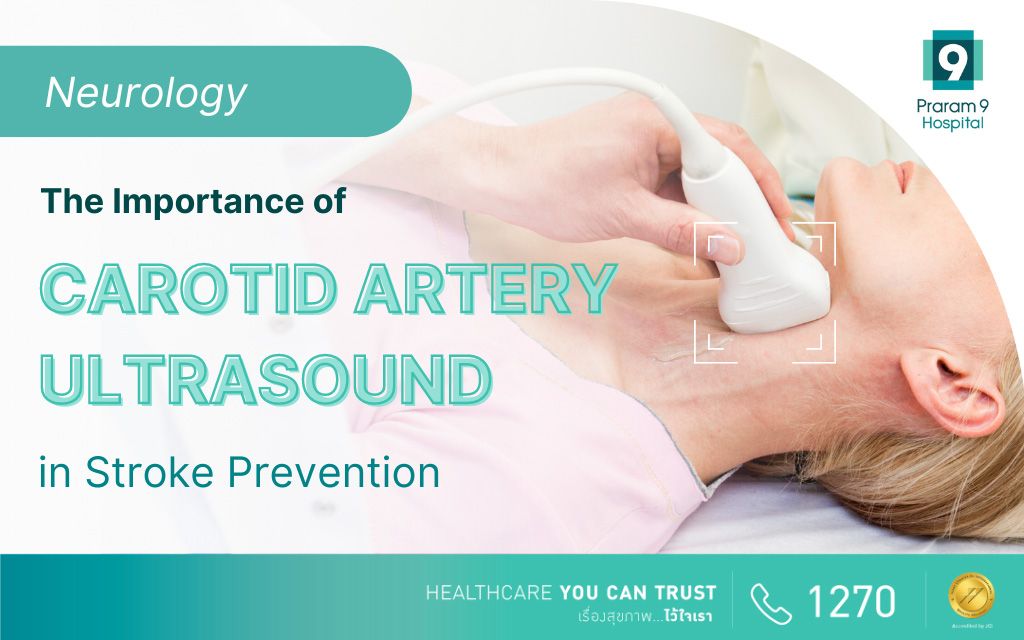Health Articles
Knowledge
The Importance of Carotid Artery Ultrasound in Stroke Prevention

Understand the significance of carotid artery ultrasound in evaluating vascular health. Learn about early detection of blockages and preventive measures. Contact us for carotid artery screenings and vascular health consultations.
Table of content
- Introduction
- What is Carotid Artery Ultrasound?
- Why is Carotid Artery Ultrasound Important?
- Who Should Get a Carotid Artery Ultrasound?
- What to Expect During the Test?
- Benefits of Carotid Artery Ultrasound
- Conclusion
Introduction
Stroke is one of the leading causes of death and disability in Thailand. Carotid artery ultrasound is a crucial diagnostic tool in stroke prevention by blockages and narrowing in the carotid arteries, which can lead to a stroke. This article explores the significance of carotid artery ultrasound, its benefits, and who should consider undergoing this diagnostic test.
What is Carotid Artery Ultrasound?
Carotid artery ultrasound is a non-invasive imaging test that uses high-frequency sound waves to create detailed images of the carotid arteries in the neck. These arteries supply blood to the brain, and detect any blockage or narrowing that can significantly increase the risk of stroke.
Why is Carotid Artery Ultrasound Important?
Detecting blockages or narrowing in the carotid arteries can help prevent strokes. Here’s why this test is important:
Early Detection
Identifies potential problems before they lead to a stroke.
Non-Invasive
It’s a safe and painless procedure.
Guides Treatment
Helps doctors determine the best treatment plan, which may include lifestyle changes, medications, or surgery.
Who Should Get a Carotid Artery Ultrasound?
Certain individuals are at higher risk of carotid artery disease and should consider getting this test:
Age
Individuals aged 50 and above
High Blood Pressure
Uncontrolled high blood pressure can damage arteries.
High Cholesterol
High levels of LDL cholesterol can lead to plaque buildup in arteries.
Diabetes
Diabetic patients are at higher risk of artery damage.
Smoking
Smoking can significantly increase the risk of carotid artery disease.
Family History
A family history of stroke or heart disease.
What to Expect During the Test
The carotid artery ultrasound procedure is straightforward and typically takes about 30 minutes:
Preparation
No special preparation is needed, but wearing loose clothing can be helpful.
Procedure
You’ll lie on an exam table, and a technician will apply a gel to your neck. A handheld device called a transducer will be moved over the carotid arteries to capture images.
Results
A radiologist will analyze the images and provide a report to your doctor.
Benefits of Carotid Artery Ultrasound
The benefits of this test are numerous:
Early Intervention
Detects problems early, allowing for timely treatment.
Preventive Care
Helps prevent strokes by identifying at-risk individuals.
Peace of Mind
Provides reassurance for those at risk of stroke.
Conclusion
Carotid artery ultrasound, a vital tool in the fight against stroke, can help prevent strokes and save lives by identifying blockages and narrowing in the carotid arteries.this test can help prevent strokes and save lives. If you are at risk, consider discussing this test with your healthcare provider to ensure your arteries are healthy and functioning properly.














